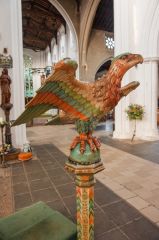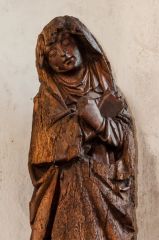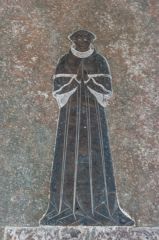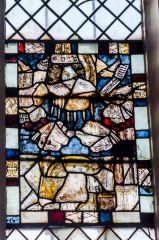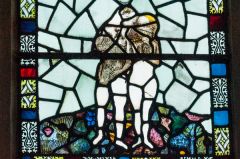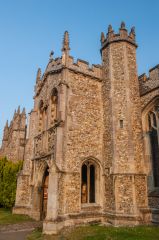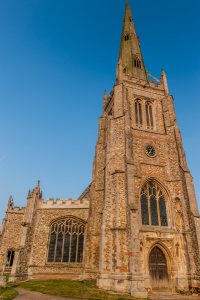
Thaxted
This large, attractive church dates primarily to the 14th and 15th centuries. It is based around a narrow nave with much wider side aisles, north and south transepts, a chancel with both north and south chapels, and spacious north and south porches.
The north porch, by which you enter the church, was given by Edward IV, who maintained a hunting lodge further down the hill (now The Recorder's House on Town Street). The south porch was a gift of Lionel, Duke of Clarence.
Both porches boast a spacious parvise, or chamber above the entrance. The parvise over the north porch once housed 'The Chapel of the Blessed John Ball', the radical 14th-century priest and martyr whose preaching helped launch the Peasant's Revolt of 1381.
The present church was begun in 1340, and the beautifully slender nave arches date from this time. The south transept, porch, and aisle were all added from 1360, the north aisle and porch in 1445, while the tower was a later addition, probably around 1485. The chancel probably stands on the site of a much earlier Saxon church.
Very finely carved 17th-century screens separate the chancel from side chapels. The south chapel features a lovely painted ceiling depicting sacramental symbols. In the chancel floor is a very well-preserved brass of a priest in academic gowns. This is thought to be Robert Wydow of Wedow, vicar of Thaxted 1481-1489. Wydow received the first Baccalaureate of Music from Oxford University.
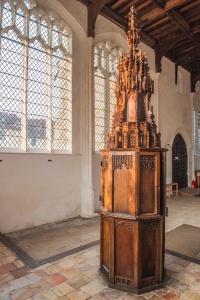
case and cover
The large east window contains fragments of medieval heraldic glass mixed with pieces by the Victorian artist Charles Kempe (look for his famous wheatsheaf symbol). There is more Kempe glass in the Becket Chapel and the south window of the Lady Chapel.
At the crossing is a bronze bust of Thaxted's most famous vicar, Conrad Noel, dubbed 'The Red' for his radical politics. Noel served from 1910-1942 and helped preserve the picturesque chantry cottage beside the church.
In the south transept is a very unusual historic treasure for a church; a Flemish tapestry dating to the 16th century. This depicts the story of Rebecca at the Well. Nearby is a small, almost unobtrusive statue of a Madonna and Child; this is thought to be German or French and dates to around 1320.
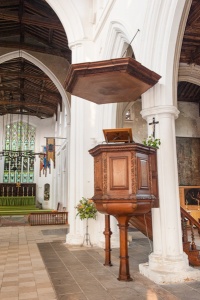
sounding board
The south aisle roof dates to 1510 and is carved with figures of angels and heraldic symbols. There is a stained-glass depiction of Adam and Eve (1450) and a partially preserved wall painting showing the martyrdom of Thomas Becket. At the east end of both north and south aisles are what is left of 15th century carved screens.
Look for figures of foliage and animals in the spandrels. There are more carved heads in the nave arches, and the Carolean pulpit (c. 1680) has carvings of garlands. One of the most interesting features inside the church is a remarkable 15th-century font case and cover. This completely encases the font, and is really quite beautifully detailed. Over the main north door is a wooden coat of arms to Queen Anne.
In the north transept is a large organ, played by composer Gustav Holst from 1916-1925 when he resided in Thaxted. The organ was made by Henry Lincoln around 1820, and came from St John's Chapel, Bedford Row.
Immediately beside the church are a pair of almshouses, flanking a footpath leading to Thaxted Windmill. The furthest cottage dates to 1714 and once housed up to 16 poor people. The closer thatched cottage (called Chantry) was built in the 14th century to house the church priest.
It was later divided into 3 separate cottages and used as an almshouse. By the early 20th century it was in dire condition and threatened with destruction before the local vicar, Conrad Noel, stepped in and launched a campaign to save the property.
The church was able to purchase Chantry and restore it for church use. The two almshouses now form an unforgettable pair of historic buildings; arguably the 'signature view' of Thaxted. See our main Thaxted article for photos.
About Thaxted
Address: Watling Street,
Thaxted,
Essex,
England, CM6 2PE
Attraction Type: Historic Church
Location: On the B184 (Watling Street) in the centre of Thaxted. For satnav use postcode CM6 2PJ
Website: Thaxted
Location
map
OS: TL610310
Photo Credit: David Ross and Britain Express
HERITAGE
 We've 'tagged' this attraction information to help you find related historic attractions and learn more about major time periods mentioned.
We've 'tagged' this attraction information to help you find related historic attractions and learn more about major time periods mentioned.
Find other attractions tagged with:
NEARBY HISTORIC ATTRACTIONS
Heritage Rated from 1- 5 (low to exceptional) on historic interest
Thaxted Windmill - 0.1 miles (Historic Building) ![]()
Tilty Church and Abbey - 2.9 miles (Historic Church) ![]()
Broxted, St Mary's Church - 3 miles (Historic Church) ![]()
Chickney, St Mary's Church - 3.1 miles (Historic Church) ![]()
Priors Hall Barn - 4.5 miles (Historic Building) ![]()
Saling Hall - 6.5 miles (Garden) ![]()
Walden Castle - 6.5 miles (Castle) ![]()
Saffron Walden Museum - 6.5 miles (Museum) ![]()
Nearest Holiday Cottages to Thaxted:
Sible Hedingham, Essex
Sleeps: 12
Stay from: £1218 - 5733
More self catering near Thaxted
